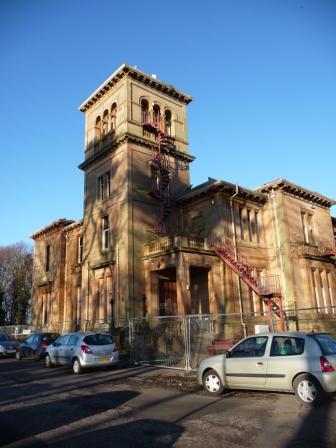Press release: Seafield House - Saved On Death Row
Press Release 15 October 2014
Seafield House - Saved On Death Row
Seafield House, Ayr, the former home of the man who built the world famous Forth Bridge, has been saved from demolition after being acquired by sympathetic developer Robin Ghosh, founder of Ecostruct Design and Build.
SAVE, working with the Friends of Seafield House, secured a reprieve for the category B listed building in 2012 when an application to demolish was submitted following a serious fire which gutted part of the building.
Though left to decay after the fire, the house remains an impressive landmark with one of the finest Italianate towers in Scotland, echoing that of the Prince Consort’s Osborne House on the Isle of Wight.
Despite the fire damage to the rich interiors the masonry shell of the house survives remarkably complete with much fine carved architectural detail.
The house was built by Sir William Arrol, the famous engineer contractor who pioneered the use of rivets in ship building as well as undertaking major civil engineering projects like the Forth Railway Bridge. Sir William had no children and after his death his widow decided to leave Seafield. During the First World War Seafield served as an Auxiliary Hospital, before becoming the town’s maternity hospital in 1920, where generations of children were born.
When a new hospital was built in 1991 Seafield House was left empty, and in 2008 a fire badly gutted the interior. The NHS sought permission to redevelop the site, including demolishing the building in 2009 and again in 2012. SAVE and the Friends of Seafield House insisted that permission to demolish should be refused and the house restored with a small amount of new building in the spacious grounds.
After the NHS put the building back on the market seeking a restoring purchaser they were approached by the Ayr based developer Robin Ghosh, whose father worked for many years as a leading doctor in the hospital.
SAVE is pleased that Robin Ghosh has taken the opportunity to restore Seafield House, and we look forward to supporting the restoration work, which will see the house converted into apartments, with a small amount of enabling works in the grounds.
Marcus Binney, SAVE’s Executive President said: “This is the best possible outcome. Mr Ghosh has a passion and a commitment to the rescue of this house and we are confident it will be a model project. It also shows once again, that it is possible to breathe new life into fine houses and landmarks which have been tragically left to decay.”
SAVE is delighted to have worked with the Friends of Seafield House, and warmly acknowledges the help and support from all those who have helped, including the architect Andrew Arrol, a relation of the original builder, the architect Patrick Lorimer, Chairman of the Friends Rob Close, and Lianne Hackett, whose tireless energy has powered the project forwards.”
For more information and images, please contact the SAVE office on 0207 253 3500/ office@savebritainsheritage.org, or Friends of Seafield House on info@friends-of-seafield-house.org.uk
NOTES TO EDITORS:
SAVE Britain’s Heritage has been campaigning for historic buildings since its formation in 1975 by a group of architects, journalists and planners. It is a strong, independent voice in conservation, free to respond rapidly to emergencies and to speak out loud for the historic built environment.
The Friends of Seafield House were established to support the campaign to save Seafield House in Ayr, securing a new use for the iconic building and developing proposals for its restoration. Its patrons are Andrew Arrol and Sir William McAlpine.
Press release issued by SAVE Britain's Heritage, 70 Cowcross Street, London EC1M 6EJ Registered Charity 269129


